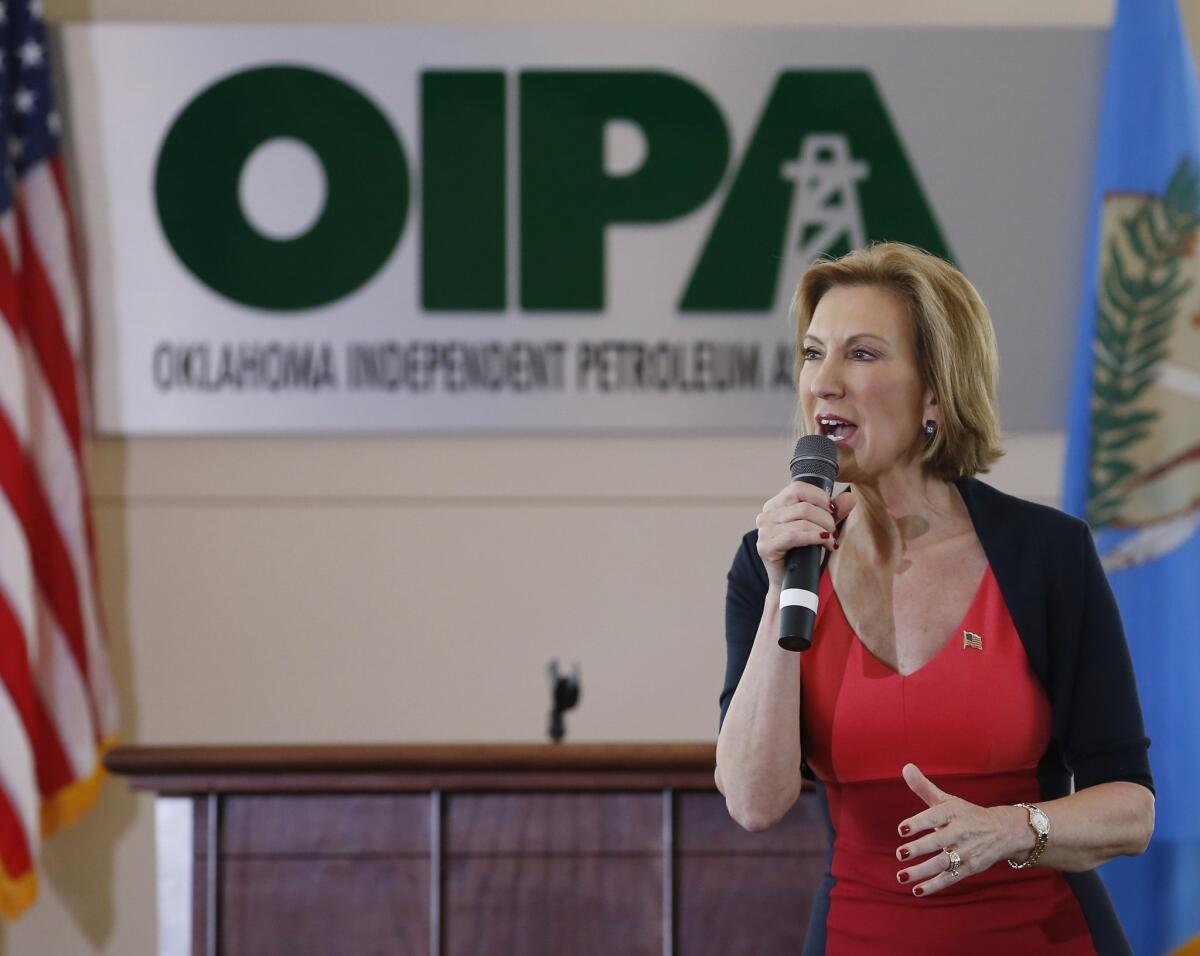A presidential campaign as reality TV

Republican presidential candidate Carly Fiorina speaks to a group of people at the Oklahoma Independent Petroleum Association in Oklahoma City on Sept. 29.
- Share via
It’s a truism in Hollywood that movies are made in the editing room. No matter how airtight the script, no matter how brilliant the actors, no matter what the director envisioned at the beginning, all bets are off when the footage makes its way to the cutting room. Plot lines shift, characters disappear, occasionally genres can change. And in the age of reality television, it’s not just a truism but standard operating procedure.
A similar process seems to be happening on the presidential campaign trail, particularly in the GOP race, where creative video editing has become both a favorite topic and a regular practice.
“This is highly edited!” said radio host Hugh Hewitt during a recent “Meet the Press” discussion about heavily doctored videos that have been circulated to discredit Planned Parenthood. “The debate the other day was highly edited.”
Hewitt’s point — made by way of defending Carly Fiorina and her attempt to will a nonexistent scenario into existence by sheer force of repetition — seemed to suggest something along the lines of “everything we consume is edited, and all editing is equal.”
Fiorina seems more than comfortable living by that rule. Her anti-Planned Parenthood monologue during the Sept. 16 GOP presidential debate included a graphic misinterpretation of pieced-together pictures and audio purporting to show, in her words, “a fully formed fetus on the table, its heart beating, its legs kicking, while someone says we have to keep it alive to harvest its brain.”
As multiple fact-checking outfits have shown, the exact situation Fiorina described does not exist in the video in question. There are images of a fully formed and moving, but not viable, fetus. The Center for Medical Progress, the antiabortion group responsible for the video, has never said those pictures are connected to Planned Parenthood or explained exactly what they show. (For what it’s worth, Jen Gunter, an OB/GYN, said in Slate and elsewhere that it appears to be a miscarriage.) As for talk of brains, that’s audio from a former biotech employee, and it’s not describing the footage CMP paired it with.
Even if most of the public isn’t buying her act, Fiorina has managed to gain politically by riding an endless wave of purposeful confusion. Since July, CMP has released a lot of videos mixing and matching material to discredit Planned Parenthood in the hope of getting the government to defund it. Some CMP undercover shots show Planned Parenthood employees talking about procuring fetal tissue for research; some of the footage is wholly unconnected with Planned Parenthood.
To get an idea of just how wide the gulf can be, consider that one image has been identified by a Pennsylvania woman as a photograph of her child, who was born in 2013 after 19 weeks’ gestation and died minutes later. This mother, an antiabortion Christian, stated on her Facebook page that she has given CMP permission to use it because she and her husband believe their son was put on Earth “to save the lives of the unborn.” It’s unlikely Planned Parenthood ever had a part in this equation. But never mind the technicalities.
Fiorina’s campaign has also gotten into the video act. It posted a mash-up of the CMP videos — an edit of the editor’s cut, if you will — suggesting that any doubts about the legitimacy of her anti-Planned Parenthood speech were merely “false attacks.” Again, we see gruesome images while hearing Fiorina’s fire-breathing from the debate lectern. The production concludes with a crescendo of menacing music and these words on the screen: “This is about the character of our nation.”
That may be the one accurate statement out there. This is about our nation’s character, specifically the weak spots that have allowed so many people to stop caring about, or even noticing, the difference between stories concocted in the editing room and precise, complicated, actual facts.
We’ve been primed by “reality” programming that is often more cartoonish and outlandish than fictional tales. And by advertising, in which truth has long been a mostly fungible commodity. Now we’re seeing it in every aspect of the political arena, as candidates baldly evade questions and follow their strategists’ script. They publish ghosted memoirs and produce convenient bio pics and YouTube moments. They are succeeding at being judged on their ability to shape — to contort — their own narratives as well as those of their opponents.
Donald Trump isn’t the only candidate running his campaign as though it were a season of “The Apprentice.” The presidential hopefuls and their teams might as well be reality show producers, exploiting whatever angle will keep our attention, crafting plot lines to attract votes, fudging the real for whatever the market will bear.
And yes, it was ever thus: Attack ads, smear campaigns, spin doctors. But it can get worse. More and more, campaigns for public office seem like reality competitions whose winner will be determined by the editors, not the voters. Unless the audience turns it off, that show will stay on the air forever.
Twitter: @meghan_daum
Follow the Opinion section on Twitter @latimesopinion and Facebook
More to Read
A cure for the common opinion
Get thought-provoking perspectives with our weekly newsletter.
You may occasionally receive promotional content from the Los Angeles Times.










